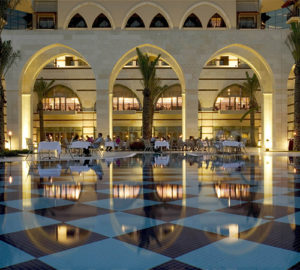The opening of a five-star hotel will endorse the commitment to elite tourism in the capital.
“Its raised ceilings and French windows, which look out over the old city, convey the grandeur and European luxury of the old days,” says a document from the Swiss hotel firm Kempinski about the Grand Hotel Manzana, which plans to inaugurate the June 7th. In a commercial association with the Cuban State, the chain has rehabilitated a huge classic building from the beginning of the 20th century that occupies an entire block and presents as the most exclusive hotel in the city. Its opening will be the major milestone of the socialist Cuba’s commitment to elite tourism in the country’s jewel, Havana.
Rescued from abandonment, the six-storey hotel will have 246 luxury rooms and suites, a terrace with a pool overlooking Old Havana, a spa, three restaurants, four bars, one overlooking the famous Floridita bar where Ernest Hemingway drank his daiquiris , And a smoking room for cigars. Its direct competition will be the Saratoga Hotel, another dazzling historical building, resurrected in 2005, which until today is the most chosen of the city, with prices between 500 and 1,200 dollars per room. His last illustrious client has been the king of Morocco Mohamed VI, who stayed there with his entourage in April.
Other projects underway in Old Havana are the Prado and Malecón Hotel, with the French chain Accor, and the Packard, with the Spanish Iberostar. Of this last building is only part of the facade, sustained during the last years by an amazing scaffold capable of withstanding cyclonic winds of 300 kilometers per hour. The work will be directed by the Spanish Pritzker Prize Rafael Moneo.
Since the thaw between the US and Cuba in 2014 the habaneros have become accustomed to the parade of personalities and unusual events. This weekend the novelty has been the premiere of shops in the commercial gallery on the ground floor of the Gran Hotel Manzana, prior to the opening of the lodging: Armani, Versace, Montblanc … A descendant of the Gucci family has put his ; Not Gucci, since the brand no longer belongs to its stock, but an assortment of expensive signatures. Giorgio Gucci said that Cuba “has become a fashion paradise” and welcomed that Havana will have a place where “the best of the European luxury market”, according to EFE. Among the guests was the artistic couple Yomil and El Dany, singers of reggaeton, the genre of erotic dancing and ode to consumption, the most popular on the island.
Prices will only be available to wealthy tourists and perhaps the nascent and minority new business class in Cuba, linked to other private businesses allowed by the state such as restaurants, hostels or tourist transport. The common citizen stops to look at the shops as an exotic for a society in which resources barely cover basic needs. A more shocking event took place a year ago: the silken Chanel parade on the Paseo del Prado in Havana, reserved for a privileged group of local and foreign guests and which sparked a certain critical stir inside.
After exporting services, especially medical missions, tourism is Cuba’s second-largest source of income, ahead of remittances, and its upward trend has made it the catalyst for a recession-ridden government and Collapse of Venezuela, its great economic partner. In 2016 the island surpassed for the first time in history the four million tourists. Canada is the first supplier and the second United States, with a potential of 2 million annually if Washington’s ban on its citizens to travel as tourists to Cuba is lifted. Until now, they travel under special permits, although the bureaucracy that was required was reduced by order of former President Barack Obama.
At the forefront of the tourism strategy is the Business Administration Group of the Revolutionary Armed Forces (Gaesa), led by the son-in-law of President Raúl Castro, General Luis Alberto Rodríguez López-Callejas. Its hotel branch, Gaviota, owns the Gran Hotel Manzana, which will be managed by Kempinski and whose construction was carried out by the French company Bouygues. It also controls the Saratoga, the future Prado and Malecon and Packard and around 60 hotels and villas throughout Cuba with 27,000 rooms altogether. More than 80% of the infrastructure is managed by foreign networks.
Abandonado por años, Resucita el lujo hotelero Capitalista de “Cinco Estrellas” en la Habana. Cuba.
La apertura de un hotel cinco estrellas refrendará la apuesta por el turismo de élite en la capital.
“Sus techos elevados y sus ventanas francesas, que dan a la ciudad vieja, transmiten la sensación del grandeur y el lujo europeo de los viejos tiempos”, avanza un documento de la firma hotelera suiza Kempinski sobre el Gran Hotel Manzana, que prevé inaugurar el 7 de junio. En asociación comercial con el Estado cubano, la cadena ha rehabilitado un enorme edificio clásico de principios del siglo XX que ocupa un bloque entero y que presenta como el hotel “más exclusivo” de la ciudad. Su apertura será el hito mayor de la apuesta de la Cuba socialista por el turismo de élite en la joya del país, La Habana.
Rescatado del abandono, el hotel de seis plantas tendrá 246 habitaciones de lujo y suites, terraza con piscina con vistas a La Habana Vieja, spa, tres restaurantes, cuatro bares, uno con vistas al famoso bar Floridita en el que Ernest Hemingway bebía sus daiquiris, y una sala para fumar habanos. Su competencia directa será el hotel Saratoga, otro deslumbrante edificio histórico, resucitado en 2005, que hasta hoy es lo más escogido de la ciudad, con precios entre los 500 y los 1.200 dólares por habitación. Su último cliente ilustre ha sido el rey de Marruecos Mohamed VI, que se hospedó allí con su séquito en abril.
Otros proyectos en marcha en La Habana Vieja son el hotel Prado y Malecón, con la cadena francesa Accor, y el Packard, con la española Iberostar. De este último edificio sólo queda parte de la fachada, sostenida durante los últimos años por un asombroso andamiaje capaz de soportar vientos ciclónicos de 300 kilómetros por hora. La obra la dirigirá el premio Pritzker español Rafael Moneo.
Desde el deshielo entre EE UU y Cuba en 2014 los habaneros se han ido acostumbrando al desfile de personalidades y a hechos inusitados. Este fin de semana la novedad ha sido el estreno de tiendas de relumbrón en la galería comercial de la planta baja del Gran Hotel Manzana, previo a la inauguración del hospedaje: Armani, Versace, Montblanc… Un descendiente de la familia Gucci ha puesto la suya; no de Gucci, pues la marca ya no pertenece a su estirpe, sino un surtido de firmas caras. Giorgio Gucci afirmó que Cuba “se ha convertido en el paraíso de la moda” y celebró que La Habana vaya a disponer de un lugar en el que se encuentre “lo mejor del mercado de lujo europeo”, según EFE. Entre los invitados estuvo la pareja artística Yomil y El Dany, cantantes de reguetón, el género del baile erótico y la oda al consumo, el más popular en la isla.
Los precios sólo estarán al alcance de turistas adinerados y si acaso de la naciente y minoritaria nueva clase empresarial cubana, vinculada entre otros sectores a los negocios privados permitidos por el Estado como restaurantes, hostales o transporte turístico. El común de los ciudadanos se detiene a contemplar las tiendas como un exotismo para una sociedad en la que los recursos cubren a duras penas las necesidades básicas. Hace un año tuvo lugar un acontecimiento más chocante: el sedoso desfile de Chanel por el Paseo del Prado de La Habana, reservado a un privilegiado grupo de invitados locales y foráneos y que despertó cierto revuelo crítico de puertas adentro.
Tras la exportación de servicios, sobre todo las misiones médicas, el turismo es la segunda fuente de ingresos de Cuba, por delante de las remesas, y su línea al alza lo ha convertido en la baza de un gobierno apurado por la recesión y por el colapso de Venezuela, su gran socio económico. En 2016 la isla superó por primera vez en la historia los cuatro millones de turistas. Canadá es el primer surtidor y el segundo Estados Unidos, con un potencial de dos millones anuales si se levanta la prohibición de Washington a sus ciudadanos de ir como turistas a Cuba. Hasta ahora viajan bajo permisos especiales, si bien la burocracia que se les requería se redujo por orden del expresidente Barack Obama.
Al frente de la estrategia turística está el Grupo de Administración de Empresas de las Fuerzas Armadas Revolucionarias (Gaesa), dirigido por el yerno del presidente Raúl Castro, el general Luis Alberto Rodríguez López-Callejas. Su rama hotelera, Gaviota, es propietaria del Gran Hotel Manzana, que administrará Kempinski y cuya construcción ejecutó la compañía francesa Bouygues. Controla también el Saratoga, los futuros Prado y Malecón y Packard y alrededor de 60 hoteles y villas por toda Cuba con unas 27.000 habitaciones en conjunto. Más de un 80% de la infraestructura está administrada por cadenas extranjeras.
Agencies/El País, Spain/Pablo de LLano/Internet Photos/ Arnoldo Varona/ TheCubanHistory.com
THE CUBAN HISTORY, HOLLYWOOD.














